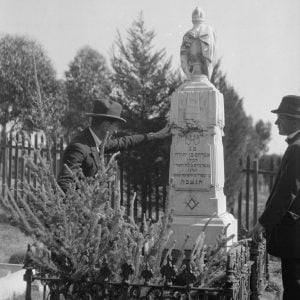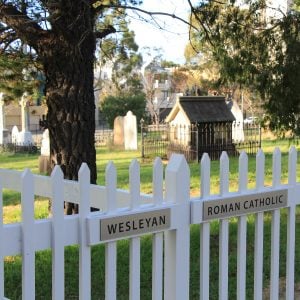Small sections of interpretive fencing have been installed at East Perth Cemeteries to assist with wayfinding and to signify the original seven independent denominational cemeteries.
East Perth Cemeteries comprises what were seven independent denominational cemeteries. Fences were an integral part of the layout and management of the place throughout the nineteenth century and were probably there from the time the land was first allocated. The timber pickets provided a sense of order and reinforced the strong sectarian divisions that existed in the colony, while on a practical level keeping out straying stock. Once the cemeteries were closed in 1899 the fences, along with grounds generally, were neglected and soon deteriorated.
In November 1920 a fire swept through the site burning crosses, ornamental fences, trees and a portion of the boundary fence. It was two hours before the fire brigade had it under control but not before irreversible and extensive damage was caused. By the mid-1920s the condition of the cemeteries had become something of a public scandal. The State Gardens Board tidied the site and repaired the fences which were in situ until 1952. The place remained unfenced until 1986 when the current perimeter fence was installed to help protect this delicate heritage place from vandalism.
Recently small sections of interpretive fencing have been installed to assist with wayfinding and to signify the original cemetery subdivisions. While they don’t fully enclose each cemetery they provide a reminder of the subdivision and enclosure that was previously associated with the place. The design has been based on historical photographs that show the fencing associated with the Church of England and Jewish cemeteries. No evidence has yet been found for the fence design associated with the other cemeteries.
To ensure the integrity and authenticity of the place no new plaques or inscriptions may be made to existing graves. However, it is recognised there are people for whom the place has special associations and meanings, generally through an ancestral or other connection. The continuation or revival of memorialisation practices is seen as a positive contribution to the cultural significance of the place. Consequently the new fencing has also been designed to incorporate memorial plaques that can be purchased by families to show connections to an identified grave or to indicate the general locality of a now unmarked burial.
These opportunities for interpretation and memorialisation are in keeping with international approaches to heritage management and interpretation. In addition they support the National Trust’s ongoing obligations for the stewardship of the Cemeteries under the Heritage of Western Australia Act.


